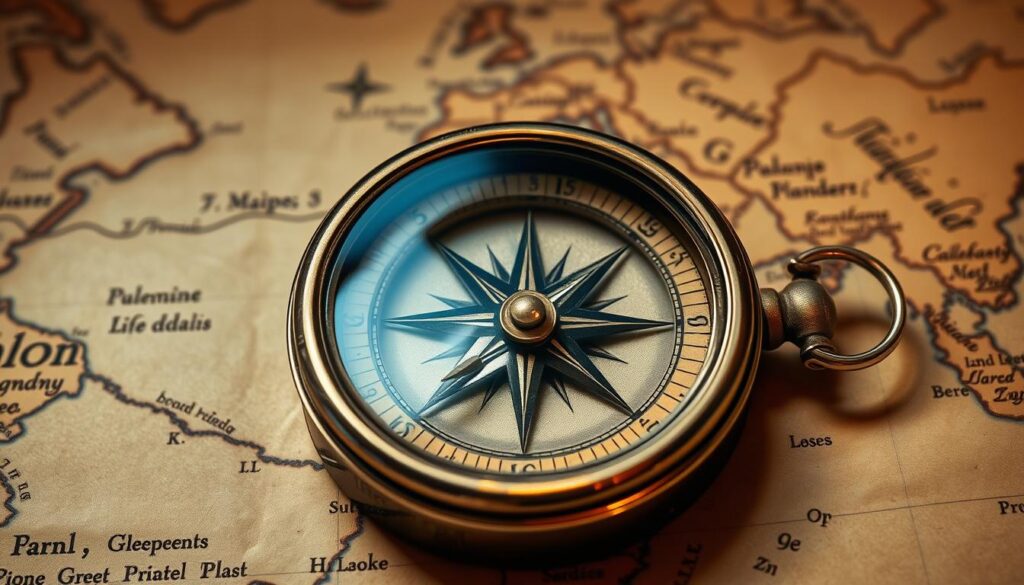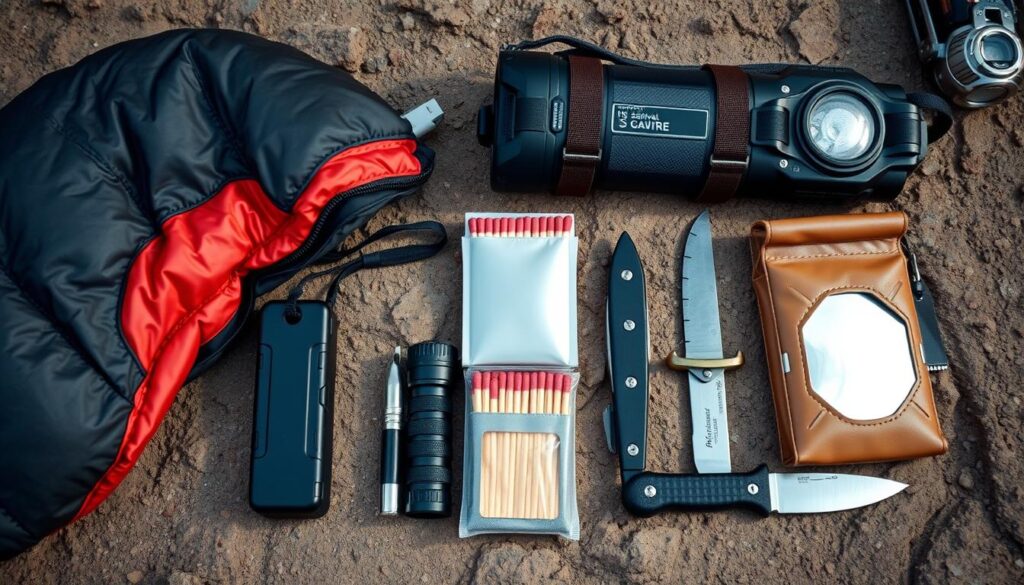As an outdoor enthusiast, I’ve learned that knowing how to use a compass is key. It’s a must-have skill for any hiking or backpacking trip.
Even seasoned backpackers might overlook their navigation skills. But when the trail disappears or is buried under snow, a compass becomes essential.
In today’s world, we often rely on GPS for navigation. Yet, knowing how to navigate with a compass and map is vital for serious outdoor adventures.
By mastering these tools, you’ll navigate confidently, even in tough environments.
Key Takeaways
- Understanding the basics of compass navigation is essential for outdoor adventures.
- A compass is a vital tool for navigation, even when GPS is not available.
- Learning to use a compass and map together boosts your navigation skills.
- Compass navigation skills are critical for hiking and backpacking trips.
- Practicing compass navigation builds your confidence in navigating.
Understanding the Basics of a Compass
Learning to navigate starts with the compass, a tool used for centuries. A magnetic compass is key for finding your way when tech fails.
A compass shows direction based on the Earth’s magnetic field. The handheld compass is great for hiking and outdoor adventures.
What is a Compass?
A compass helps you navigate and find your way. It aligns with the Earth’s magnetic field. This makes it reliable for direction.
The compass has a magnetized needle that points to magnetic north. It’s the heart of the compass.
Components of a Compass
Knowing the parts of a compass is important for good navigation. The main parts are:
- The baseplate, the compass’s base.
- The direction of travel arrow, shows where you’re going.
- The index line, helps with bearings.
- The rotating bezel, marked with degrees.
- The magnetized needle, points to magnetic north.
- The orienting arrow and lines, for map alignment.
- The declination scale, adjusts for magnetic and true north.
For more on using a compass, check out American Hiking. They offer detailed guides and tips.
Types of Compasses
Compasses come in different types for various uses. The main ones are:
- Baseplate compasses, simple and versatile, great for orienteering.
- Lensatic compasses, precise, mainly for military use.
- Thumb compasses, small, for quick checks.
Navigation experts say a good compass is reliable and fits your needs. Picking the right compass is key for navigation.
Why Knowing How to Use a Compass is Important
In today’s world, knowing how to use a compass is more important than ever. GPS devices are handy, but they can fail due to dead batteries or lost signals. A compass, being simple and battery-free, is a must-have for navigating the wilderness.

Navigation Skills
For those who love hiking or orienteering, learning to navigate is key. Using a compass helps you find your way in new places. It’s not just about reading the compass; it’s about using it with a map to figure out where you are and where you’re going.
Good navigation means knowing how to take accurate bearings, understand map scales, and spot landmarks. Mastering these skills lets outdoor lovers explore with confidence and safety.
Safety in the Wilderness
When you’re in the wild, staying safe is the top priority. A compass can save your life when it’s dark or GPS fails. It helps you stay on course, avoid getting lost, and find your way back if needed.
Knowing how to navigate with a compass also lowers the risk of accidents. It makes your outdoor adventures safer and more fun, whether you’re hiking, camping, or orienteering.
Getting Started: The Essential Gear
Before you go, learn about the key tools for navigation. The right gear makes your outdoor adventure better.
A compass is a must-have for navigation. There are many types, each with its own benefits. The baseplate compass is simple yet effective for backpackers. Lensatic compasses are precise but might be harder to learn.
Choosing the Right Compass
Choosing a compass depends on what you need. A handheld compass is easy to use. A digital compass offers extra features like altitude and temperature.
Think about accuracy, durability, and extra features when picking a compass. These help during your outdoor adventure.
Additional Tools to Consider
Other tools can make navigation better. A detailed topographic map helps you understand the terrain. A GPS device, watch, and whistle are also useful.
With these tools and a good compass, your outdoor adventure will be safe and fun.
How to Read a Compass
Reading a compass is key to navigating the wilderness. It’s about knowing a few important things. These help you find your way.
Understanding Bearings
A bearing shows the direction to a place, measured in degrees from true north. To get a bearing, you need to know how to use your compass’s degree marks. The azimuth ring or dial has degrees from 0 to 360. This lets you figure out the exact direction you should go.
For example, to go east, your bearing is 90 degrees. Getting better at taking bearings will make you more skilled at navigating.

Finding True North
True north is the Earth’s North Pole, a fixed point for navigation. But, a magnetic compass points to magnetic north, not true north. This is because of the Earth’s magnetic field. To find true north, you must adjust for the magnetic declination, the difference between magnetic and true north.
Let’s say you’re in an area with a declination of 10 degrees east. You would adjust your compass reading to find true north. This is important for accurate navigation over long distances.
Using a Compass Rose
A compass rose is a symbol on maps showing the cardinal directions and their points in between. When using a compass with a map, align the compass rose with the direction-of-travel arrow. This helps you orient your map to the real world.
| Component | Function |
|---|---|
| Direction-of-Travel Arrow | Indicates the direction you need to go |
| Orienting Lines | Used to align the compass with the map |
| Magnetic Needle | Points towards magnetic north |
By learning about bearings, true north, and compass roses, you can read a compass well. This will improve your navigation skills.
Setting Your Course
Orienteering with a compass needs precision, starting with setting your course right. You must learn to take a bearing and adjust for magnetic declination. This ensures your navigation is spot on.
How to Take a Bearing
To take a bearing, align your compass with your direction. Hold it level and turn the bezel until the arrow points to your goal. The bearing is then shown on the bezel. Make sure your compass is away from metal to avoid interference.
Key steps to take a bearing:
- Hold the compass level and steady.
- Align the direction-of-travel arrow with your goal.
- Rotate the bezel to match the magnetic needle.
- Read the bearing off the bezel.
Adjusting for Magnetic Declination
Magnetic declination is the difference between magnetic and true north. To adjust, know the declination for your area. You can find this on topographic maps or online. If declination is east, subtract it from your bearing. If it’s west, add it.
For example: If your bearing is 270 degrees and the declination is 10 degrees east, your adjusted bearing would be 260 degrees.
By learning to take a bearing and adjust for declination, you’ll navigate better. This makes you more confident in orienteering.
Navigating with a Compass
When you head into the wilderness, a compass is key. It’s vital for hiking through forests or crossing deserts. Knowing how to use a compass can mean the difference between finding your way and getting lost.
Using a compass is more than just pointing it towards your goal. It also needs map reading and spotting landmarks. These skills help you figure out where you are and where you’re going.
Combining Map Reading with Compass Use
Using a map and compass together is a smart move. First, lay your map flat and align the compass with the grid lines. Then, turn the bezel until the arrow points to your destination on the map.

Next, hold the compass level and turn until the magnetic needle lines up with the bezel’s north indicator. The arrow will now point towards your goal. This method makes sure you’re on the right path.
Identifying Landmarks
Spotting landmarks is also key. These can be natural things like rivers or mountains, or man-made ones like trails or buildings. Recognizing these on your map and in real life helps you stay on track.
To use landmarks well, first mark them on your map. Then, use your compass to get a bearing on them. This shows you where you are in relation to the landmark and helps you adjust your path.
By mixing map reading, compass use, and landmark spotting, you can navigate confidently. This method helps you stay on course and reach your destination, no matter where you are.
tag.
6. To develop the keyword placement matrix, I will ensure that the density of keywords like “compass,” “navigation,” and “orienteering” does not exceed 2% of the total words.
7. I will create short paragraphs to improve readability and ensure that the Flesch Reading Ease score is between 60-70, and the Flesch Kincaid Grade is at the 8th-9th grade level.
8. The recommended text size for section8 is approximately 300-400 words.
Here’s the content for section8:
Common Mistakes and How to Avoid Them
Mastering compass navigation is not just about knowing how to use it. It’s also about avoiding common mistakes that can lead to errors. These mistakes can throw you off course. But, by knowing these pitfalls, you can improve your skills and stay on track.
Overlooking Declination
One big mistake is overlooking declination. Declination is the difference between magnetic north and true north. If you don’t account for it, you can make big navigation mistakes. To avoid this, it’s key to adjust your compass for declination.
For example, if you’re in an area with a declination of 10 degrees east, you’ll need to adjust your compass. It’s also important to note that declination varies depending on your location. So, always check the declination for your area before you go.
Misinterpreting Readings
Another mistake is misinterpreting compass readings. This can happen if the compass is not held level or if the needle is not aligned right. To avoid this, hold the compass level and steady, letting the needle settle before reading.
It’s also important to know how to read the compass dial. The direction-of-travel arrow should be pointing towards your destination. And the magnetic needle should be aligned with the magnetic north indicator. By double-checking your readings and making sure your compass is calibrated, you can avoid misreading and stay on course.
Practicing Compass Skills
Practicing with a compass is key for navigating outdoors. It’s important to do exercises often and use your skills in real situations.
Regular practice helps you learn to use a compass in different places and weather. This makes you more confident in navigating.
Simple Exercises to Try
Start with simple exercises to build your confidence. Try taking bearings on known landmarks and check your accuracy. Also, practice orienting your map with your compass.
- Take bearings on multiple landmarks to improve your accuracy.
- Practice using your compass in different environments, such as forests or open fields.
- Use your compass to navigate a simple course, like a triangle or a square.
Setting up an obstacle course and navigating it with your compass is another good exercise. It helps you stay on track and avoid getting lost.
Real-World Navigation Scenarios
When you’re good at basic exercises, try using your skills in real situations. This could be navigating a park or a wilderness area with your compass and map.
Look for landmarks and use your compass to figure out where to go. Also, practice adjusting for magnetic declination to improve your navigation.
| Scenario | Compass Skill | Tips |
|---|---|---|
| Navigating through a dense forest | Taking accurate bearings | Use visible landmarks to check your direction. |
| Orienting a map | Aligning map features with surroundings | Ensure your map is correctly oriented before taking bearings. |
| Cross-country navigation | Using a compass with a map | Regularly check your progress and adjust your course as needed. |
By practicing these skills, you’ll get better at using your compass for navigation. This will make your outdoor adventures more enjoyable.
When to Rely on a Compass vs. GPS
Knowing when to use a compass versus GPS is key. Both tools are important for navigation. It’s important to know their strengths for finding your way.
The choice between compass and GPS is a big one. GPS is handy and precise but can run out of battery. A compass, on the other hand, is reliable and doesn’t need batteries. It’s perfect for the wilderness.
Advantages of Traditional Navigation
Using a compass has many benefits. It’s a skill that doesn’t need batteries or satellite signals. This is great in places where GPS signals are weak or gone.
It also helps you understand your surroundings better. You learn to read maps and spot landmarks.
- Reliability in remote areas without GPS coverage
- Enhances map-reading and landmark identification skills
- No dependency on batteries or electronic signals
Limitations of Technology
GPS has changed navigation a lot. But, it has its downsides. It can be affected by clouds, canyon walls, or dense forests. Also, if the batteries run out, you’re left without a way to navigate.
In short, both compass and GPS are essential for navigation. Knowing when to use each is vital. By mixing old skills with new tech, you’re ready for any situation.
Advanced Techniques for Expert Navigators
To improve your navigation skills, learn advanced techniques like triangulation and re-sectioning. These methods help you find your exact location more precisely. They are key for expert navigators.
Triangulation is a key technique. It uses multiple landmarks and bearings to find your exact spot. By identifying three or more landmarks and taking bearings with your compass, you can find your location. This method is great for orienteering and navigating in the wilderness.
Re-sectioning is another valuable technique. It involves taking bearings on visible landmarks and plotting your position on a map. This method is great for confirming your location when you’re not sure.
Triangulation
To use triangulation well, choose landmarks that are far apart and easy to spot on your map. The more accurate your bearings, the more precise your location will be. Practicing this technique will make you more confident in your navigation.
Re-Sectioning Techniques
Re-sectioning requires knowing how to use your compass with a map. By taking bearings and plotting them on your map, you can find your location. This technique works best in areas with clear landmarks.
Mastering these advanced techniques will greatly enhance your navigation skills. You’ll become a more skilled and confident navigator.
Conclusion: Mastering Your Compass Skills
Learning to use a compass is key for a great outdoor adventure. It’s useful for hiking, camping, or exploring new places. With compass skills, you can navigate with ease and accuracy.
Key Takeaways
This guide has taught you the basics of compass navigation. You now know how to use bearings, adjust for magnetic declination, and mix map reading with compass use. These skills are vital for navigating well and will make your outdoor adventures better.
Further Learning Resources
To get even better at navigation, check out online tutorials, courses, or books on wilderness survival. The Outward Bound offers training that includes compass navigation. Keep practicing and learning, and you’ll get better at using a compass. You’ll feel more confident navigating the outdoors.
FAQ
What type of compass is best for hiking and backpacking?
For hiking and backpacking, a baseplate compass or a lensatic compass is best. I like a baseplate compass, like the Suunto M-3, for its simplicity.
How do I adjust for magnetic declination when using a compass?
To adjust for magnetic declination, know the declination value for your area. Then, rotate the bezel to compensate. Always check the declination value before you go.
Can I rely solely on a GPS device for navigation?
While GPS devices are handy, use a compass as a backup. GPS can lose signal or run out of battery, making a compass reliable.
How do I use a compass with a map?
To use a compass with a map, orient the map to the compass. Align the map’s grid lines with the compass’s direction-of-travel arrow. This helps you navigate better.
What are some common mistakes to avoid when using a compass?
Common mistakes include overlooking declination and misinterpreting readings. Always double-check your readings and hold the compass level to avoid errors.
How do I practice my compass skills?
Practice your compass skills by doing simple exercises, like taking bearings. Try navigating in different places, like woods or mountains, to build confidence.
What is the difference between a magnetic compass and a digital compass?
A magnetic compass uses a magnetized needle, while a digital compass uses electronic sensors. I prefer a magnetic compass, like the Brunton Eclipse 8099, for its reliability.
How do I choose the right compass for orienteering?
For orienteering, use a thumb compass or a baseplate compass with a sighting mirror. I like a thumb compass, like the Suunto M-5, for its compact design.
Can I use a compass in conjunction with other navigation tools?
Yes, you can use a compass with other tools like a GPS device, map, and altimeter. I use a mix of tools for accurate navigation during my adventures.



